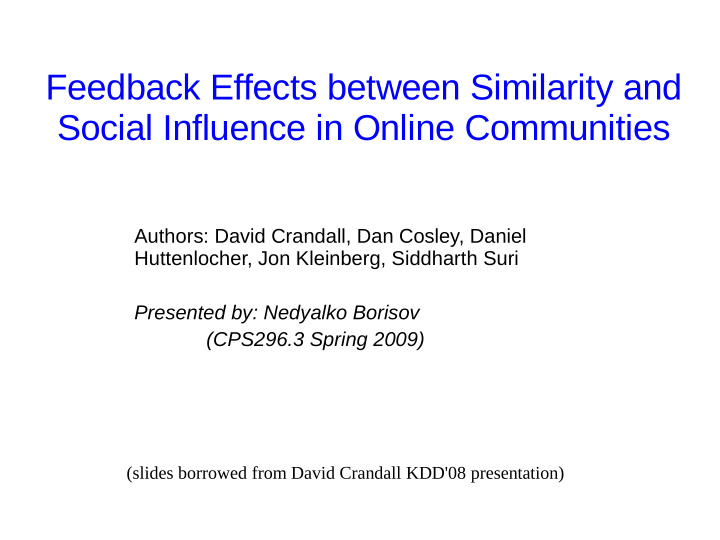



Feedback Effects between Similarity and Social Influence in Online Communities Authors: David Crandall, Dan Cosley, Daniel Huttenlocher, Jon Kleinberg, Siddharth Suri Presented by: Nedyalko Borisov (CPS296.3 Spring 2009) (slides borrowed from David Crandall KDD'08 presentation)
Homophily in social networks “Birds of a feather flock together” Caused by two related social forces [Friedkin98, Lazarsfeld54] Social influence: People become similar to those they interact with Selection: People seek out similar people to interact with Both processes contribute to homophily, but Social influence leads to community-wide homogeneity Selection leads to fragmentation of the community fragmentatio homogeneit n y
Importance to online communities Together these forces shape how a community develops important for understanding health, trajectory of community Applications in online marketing viral marketing relies upon social influence affecting behavior recommender systems predict behavior based on similarity like selection vs. social influence, these are in tension We study two questions in large online communities How do selection & social influence interact to create social networks? Is similarity or interaction more predictive of future behavior?
Main questions How do similarity and social ties compare as predictors of future behavior? viral marketing relies upon social influence affecting behavior recommender systems predict behavior based on similarity like social influence and selection, these are in tension Can we quantify and model the way in which selection and social influence interact to create social networks? important for understanding health, trajectory of a community
Interplay between influence and similarity How does first interaction affect similarity? Selection Social influence dominates? Transient effect? dominates? similarit similarit similarit y y y tim first tim first first tim e e e interactio interactio interactio n n n Wikipedia: a large collaborative social network users interact by posting to each others’ user-talk pages user interests revealed by article edit patterns rich, publicly-available, fine-grained log
Results
Results Slower, long-term increase after first interaction (social influence) Rapid increase in similarity before first interaction (selection)
Results Slower, long-term increase after first interaction (social influence) Rapid increase in similarity before first interaction (selection) Effect is qualitatively stable across populations (admins/non-admins, heavy/light users, etc.) across different time scales, similarity metrics, languages, etc.
Holme and Newman Model Each node has a single categorical attribute (one out of G possible opinions) In each step, a node changes its opinion to match a neighbor's opinion re-wires one of its links to connect to someone of the same opinion Not able to model Wikipedia users (too simple)
A model of user behavior We model systems where people interact & do activities each user u has a history of k most recent activities, E k (u) At each time step, user u either, interacts with another user, choosing someone who has engaged in a common activity or someone at random performs an activity, choosing as follows:
Simulation results We used the model to simulate user behavior in Wikipedia using maximum-likelihood estimates of the parameters simpler models (e.g. [Holme-Newman06] ) do not produce this effect Simulated Wikipedia result Actual Wikipedia result interacting interacting users users
Predictive value [Backstrom06] found that the more friends in a community, the higher a user’s probability of joining that community We compare similarity and social ties in predicting behavior in Wikipedia, social ties are more predictive in LiveJournal, interest similarity is more predictive social ties social ties similarit similarit y y
Conclusions We studied the interplay between selection and social influence in online communities Modeled the feedback between activities and interactions models individual behavior; explains aggregate phenomenon Compared social ties, similarity as predictors of behavior social ties better in Wikipedia, similarity better in LiveJournal
Discussion Can this framework compare different social networks? Can it suggest alternative/optimal designs? Is this framework sufficient for social networks like Facebook? Can all users fit the model? Or just some of them?
Recommend
More recommend